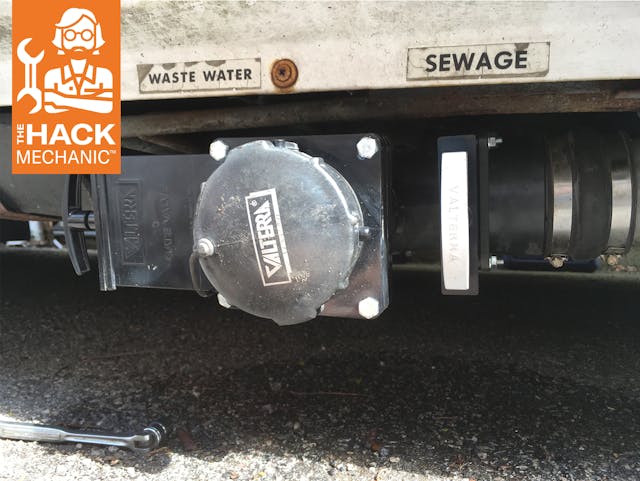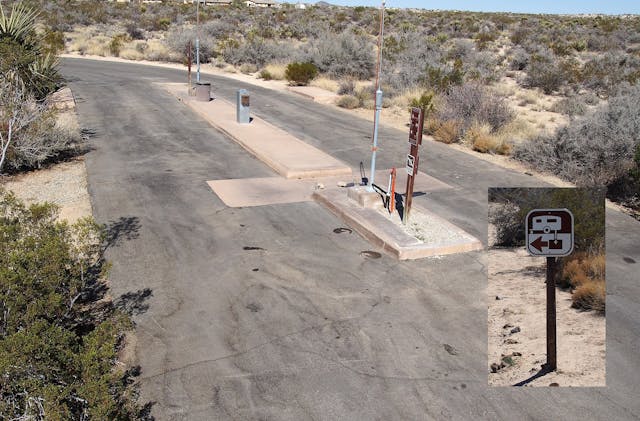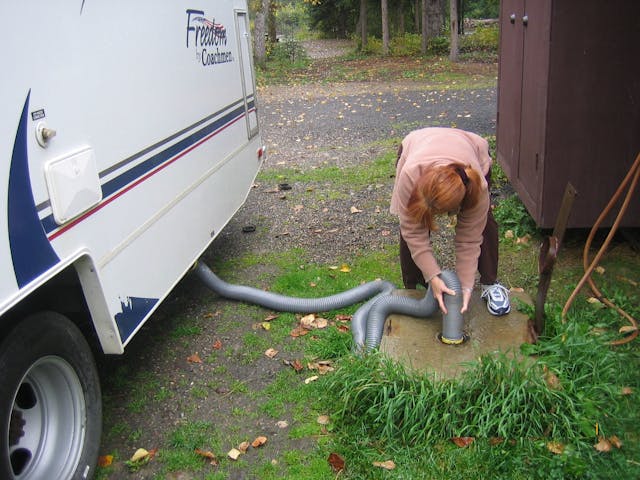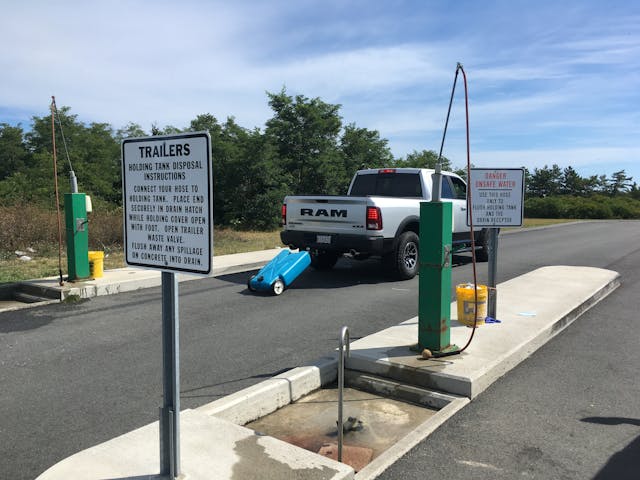The dirty little secret of RV ownership

I’m stunned by all the responses to the story I wrote a couple of weeks ago about my mini adventures in a mini RV. I guess that I’m not the only vintage car owner who has dipped a toe into these waters. Thank you all so much for your input—both pro and con—on RV ownership.
Now that you’ve convinced me we’re all friends, I’m going to drill down into the nitty gritty and write about the dark underbelly of RV use. We’re going to discuss something usually not talked about in polite company—dumping the RV. And I don’t mean leaving it behind for a nice hotel room or B&B. Although this discussion may cause you to do exactly that.
First, you must understand that, for 35 years, I was an engineer. I’m now retired from that profession, but I still very much think like an engineer. As a kid watching the U.S. space program, I remember learning that the Jules Verne-like image of having one big rocket that takes off from the Earth, lands tail-first on the moon, and returns home the same way was impractical, and instead there was this complicated solution involving blasting off in the multi-stage Apollo rocket, shedding stages, flying to the moon, deploying the Lunar Excursion Module (LEM) that looked nothing like the first rocket because there’s no atmosphere on the moon to create drag, docking with the LEM so people could crawl into it, landing on the moon in it, leaving half of the LEM behind because landing and taking off are different tasks, docking with the remaining half, crawling back into the command module, jettisoning the other half of the LEM, transiting back to Earth, leaving the last stage of the rocket behind, and landing in the tiny Apollo capsule that had a heat shield in the bottom to protect the astronauts from burning up during re-entry through Earth’s atmosphere. It was complex, but it all was necessary to accomplish the task.
OK, I know what you’re thinking. All that time spent rebuilding that Lotus Europa scrambled Siegel’s brain. What the hell does any of this have to do with RV plumbing? The point is that things that seem clunky or awkward sometimes have a certain elegance when you understand how their design flows naturally from the requirements.
As I said in the RV piece a few weeks back, the major thing that separates an RV motorhome or trailer from a camper is the presence of a toilet. Indoor plumbing, where waste is simply carried away into the ground through rigid plumbing by an unbounded supply of water, is a beautiful and seamless thing. But in an RV, you’re forced to be more involved with the mechanics.
RVs have three tanks: fresh water, gray water, and black water. Fresh water is self-explanatory. The gray water tank holds the sink and shower drain runoff. The black water tank holds sewage. The size of the tanks is larger on larger RVs, but they too eventually have to be emptied.
And thus we come to the essential rite of passage of RV ownership—dumping the RV. In my previous RV piece, I talked about the difference between campgrounds and RV campgrounds, and how any place that calls itself an RV park or campground has hookups at each site for electricity and water. In addition, there’s almost always a place for the RVs to dump their tanks. Sometimes each site has its own sewage port (and we’ll get to that), but it’s more common for the campground to have a central “dump station” with several drive-through bays not unlike a gas station.

So, you drive your rig to the dump station. The RV’s gray and black water tanks both are connected to a standard cylindrical 3-inch dump valve located low on the RV, usually on the side. The outside of the valve has bayonet-style twist-lock tabs on it. You undo the cover to the valve, and twist-lock one end of an accordion-style collapsible plastic dump hose onto it. You stretch the other end of the hose to the inlet pipe at the dump station. Inexplicably, this other end does not have a twist-lock connector. It just rests on top of the pipe. To secure it, there’s sometimes a hinged metal plate that you tilt over and rest on top. Sometimes there’s a half a cinder block. Sometimes there’s a big rock. Sometimes there’s nothing, in which case you need to convince your spouse to hold it there or rest his or her foot on it, because, trust me, you really don’t want the end of the hose to pop off. Totally not kidding about any of this.

When the hose is secured at both ends, you then open the valves to the tanks. On small-to-midsized RVs, the dump valves have a T-handle that, when you pull it out, slides open a gate. Fully equipped RVs may have an electrically operated valve instead. In either case, you release the black water tank first, then the gray water tank, as the gray water helps to flush the waste out of the accordion-like dump hose. Then you ask your spouse to flush the toilet a few times for good measure. When the tanks are emptied, you close the valves, disconnect the hose from the RV’s dump valve, and screw the cap back on.

Oh, but you’re not done yet. As you can imagine, that collapsible dump hose, with all its nooks and crannies, gets nasty, so you really want to clean it out as well as possible. Most dump stations have a spray nozzle, or at least running water, that you use to rinse the dump hose, whose accordion-like form-factor makes it a little ungainly to clean; you wind up rinsing it and lifting it up along its floppy extent several times to try to empty it out as completely as possible into the sewage port, all while your spouse is still standing with his or her foot on the end. Then you put the dump hose away—and by “away,” I don’t mean inside the RV. No matter how many times you’ve rinsed it, you don’t want it in there. My Winnebago Rialta is a tiny RV with no external storage bins, but even it has a dedicated place to put the dump hose.

You do all this wearing disposable gloves and try not to get anything on your shoes. Not quite the lure of the open road, is it?
Because of all this, some RV owners try to not use the toilet in their RV at all—or only to pee in … not, you know—and instead rely on using the facilities in the RV campgrounds. Others regard use of a bathroom as a very personal thing and think that even the suggestion of relying on public RV restrooms is a total non-starter as far as RV ownership.
My wife and I are very pragmatic people. We came from a history of backpacking and camping where we’d spend a week or two at a time in the back country with no facilities at all. The shower and hot water tank in our Rialta are both so small that it’s simply more convenient and pleasant to use the shower facilities in a campground, so we’re in and out of there anyway. But having the bathroom right there in the RV is great at three in the morning, or at the end of a bike ride—well worth having to dump the tanks. So, we, um, share the load.
Now, if you’re at a campground that has individual sewage ports at each campsite, you don’t need to drive the motorhome or trailer to the dump station; you simply connect the accordion hose from the dump valve to the port and leave it there, with a well-placed cinder block over the end of the hose. If only it was that simple. We’re all familiar with the saying about something flowing downhill, and the problem is that some degree of engineering is necessary to ensure that there’s a uniform downhill path from your RV’s dump valve to the port. So, among the products you never knew existed is an RV “sewer hose support,” a set of U-shaped plates in descending heights that snap onto the dump hose and collectively ensure that it doesn’t sag in the middle. I’ve seen some enterprising motorhome and trailer owners use actual ramps or small ladders to do the same thing. Where trailers are installed at a campsite for months, you’ll sometimes see makeshift PVC piping instead.

To fully describe the last piece of the Apollo-like RV waste disposal picture, I need to delve into some of the differences between motorhomes and trailers that some folks commented on in my last post. A motorhome has the vehicle and the living space all in a single unit. The advantages are that, like on a bus, one person can drive while another takes advantage of the interior space to sleep, use the rest room, etc. The disadvantages are that you have one large complex vehicle that can’t easily be parked at places other than campgrounds. This is why you see full-sized motorhomes pulling smaller vehicles that can be used for sight-seeing or grocery-getting (I’ll admit that, even with our small RV, my wife and I sometimes use our bikes this way). A trailer, on the other hand, can be purchased in whatever size and set of amenities you like, and can be pulled by any number of capable trucks or SUVs that can then be unhooked and used to go into town.
But because trailers get unhooked, there is typically more setup required for them at campsites than motorhomes. Legs typically get extended at all four corners in order to stabilize and level the unit. In large trailers, the Swiss army knife-like features of slide-out extensions and fold-out screened-in porches get deployed. If the campground doesn’t have individual sewage ports at each site and instead has a central dump station, you don’t want to have to retract all these and re-connect the trailer to the truck each time you need to empty the tanks.
So how do you dump them?
You have to appreciate that, when we first bought the Rialta and began taking it to campgrounds three years ago, I hadn’t wrapped my head around these issues. But I began noticing something funny. Nearly all trailers and some big motorhomes had a plastic two-wheeled thing with a handle that looked like a Little Tykes cart. Sometimes I’d see one strapped to the ladder on the back of a trailer; other times it was stuffed below the trailer. I thought … firewood hauler? Something to transport the dirty dishes back and forth to the washing station?

Then I noticed that, unlike a cart, it had no sides. Then I saw one being towed very slowly behind a pickup truck, the handle latched onto the trailer hitch. Then I saw the driver pull into the dump station.
Oh. My. God.

It’s the necessary consequence of not being able to get the trailer easily to the dump station. It’s the Lunar Excursion Module, except instead of ferrying astronauts from the command module to the moon, it’s transporting poop.
They’re called “RV portable waste tanks.” I call them “dump caddies,” only I don’t say “dump.” They come in a variety of sizes. Most have a top fill valve and a bottom release valve, both of which accept standard 3-inch sewage hoses, and have a breather valve on the top (as you drain them, you have to let air in, as you do with a gas can or a big water jug with a spigot), but the less expensive ones don’t have the release valve at the bottom, and are drained by tipping the unit. I’ve seen people dump them by literally just dumping them, without a hose, into the sewage port at RV dump sites, which tend to be recessed like sinks. That’s a little closer to, as they say, watching the sausage being made than I prefer to get. Oh—a fill indicator screws into the breather hole. They call it a “bobber.” A bobber? Really? Why not go all-in and just call it a “floater?” Hey, I don’t write the ad copy.
Before I leave this gritty slice of RV life, I wanted to touch on one last issue. In the last article, I said that “Buying a vehicle with a bathroom in it is the single smartest automotive decision I’ve made in decades. Simply being able to do some outside activity like take a hike or ride on a bike trail and return to a vehicle with a bathroom in it, is a godsend, particularly in these COVID-19 times, when we’re trying to stay isolated and safe.” That’s true, but it glosses over the fact that, if you’re not returning to a campground with a dump station, you now have a tank that you need to empty somewhere. There are websites and phone apps devoted to finding nearby dump sites (I’ve told my wife that, if I die, she is to clear my browser history so no one will find my visits to rvdumps.com), but in the leafy Boston suburb where we live, there essentially are no such sites. The nearest one is 20 miles from me, caters to buses, and charges $50 a load (my wife deadpanned “that’s a sh*tload of money”).
I try not to get too wrapped around the axle about this. The first time I was faced with emptying it, I used a spare oil change pan with a spigot, and transferred the contents into the toilet closest to the front door of the house. I plan to buy a small (5 gallon) portable tank with the proper fittings that lets me do this in a more contained fashion. I looked at seeing if I could easily install a 3-inch capped fitting inside my house (or even better, outside), but it’s just not worth it for the number of times it happens.
There is more—the use of fast-degrading RV toilet paper, chemicals to keep the odor level in the black water tank down, deep-cleaning to remove stuck solids—but in the interest of decorum, I’ll stop.
So, now you know. It’s not time on the road. It’s not privacy issues. It’s not a lack of storage. It’s this. The dump. And no one tells you in advance. If you or your spouse recoil in horror from the thought of any of this, you’re not going to enjoy owning or even renting an RV.
But hey, when you see an RV driving down the road with a plastic cart strapped to the back, you can feel special knowing what it’s for.
***
Rob Siegel has been writing the column The Hack Mechanic™ for BMW CCA Roundel magazine for 34 years and is the author of six automotive books. His most recent book, Just Needs a Recharge: The Hack Mechanic™ Guide to Vintage Air Conditioning, is available on Amazon (as are his other books), or you can order personally-inscribed copies here. His new book, The Lotus Chronicles, will be released this fall.

